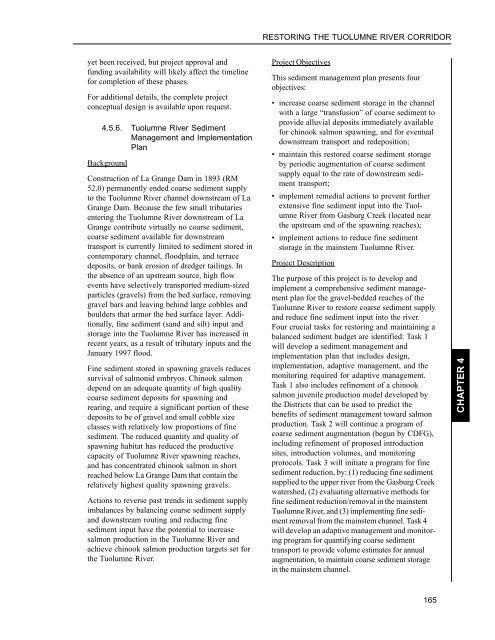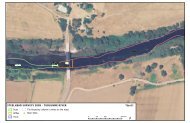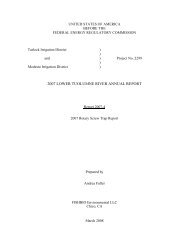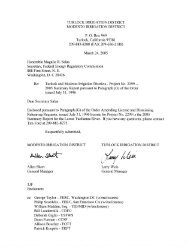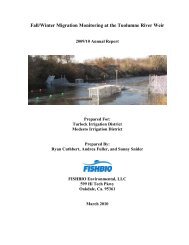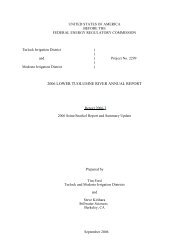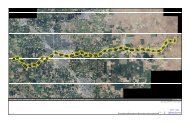Tuolumne River Report - U.S. Fish and Wildlife Service
Tuolumne River Report - U.S. Fish and Wildlife Service
Tuolumne River Report - U.S. Fish and Wildlife Service
You also want an ePaper? Increase the reach of your titles
YUMPU automatically turns print PDFs into web optimized ePapers that Google loves.
RESTORING THE TUOLUMNE RIVER CORRIDORyet been received, but project approval <strong>and</strong>funding availability will likely affect the timelinefor completion of these phases.For additional details, the complete projectconceptual design is available upon request.4.5.6. <strong>Tuolumne</strong> <strong>River</strong> SedimentManagement <strong>and</strong> ImplementationPlanBackgroundConstruction of La Grange Dam in 1893 (RM52.0) permanently ended coarse sediment supplyto the <strong>Tuolumne</strong> <strong>River</strong> channel downstream of LaGrange Dam. Because the few small tributariesentering the <strong>Tuolumne</strong> <strong>River</strong> downstream of LaGrange contribute virtually no coarse sediment,coarse sediment available for downstreamtransport is currently limited to sediment stored incontemporary channel, floodplain, <strong>and</strong> terracedeposits, or bank erosion of dredger tailings. Inthe absence of an upstream source, high flowevents have selectively transported medium-sizedparticles (gravels) from the bed surface, removinggravel bars <strong>and</strong> leaving behind large cobbles <strong>and</strong>boulders that armor the bed surface layer. Additionally,fine sediment (s<strong>and</strong> <strong>and</strong> silt) input <strong>and</strong>storage into the <strong>Tuolumne</strong> <strong>River</strong> has increased inrecent years, as a result of tributary inputs <strong>and</strong> theJanuary 1997 flood.Fine sediment stored in spawning gravels reducessurvival of salmonid embryos. Chinook salmondepend on an adequate quantity of high qualitycoarse sediment deposits for spawning <strong>and</strong>rearing, <strong>and</strong> require a significant portion of thesedeposits to be of gravel <strong>and</strong> small cobble sizeclasses with relatively low proportions of finesediment. The reduced quantity <strong>and</strong> quality ofspawning habitat has reduced the productivecapacity of <strong>Tuolumne</strong> <strong>River</strong> spawning reaches,<strong>and</strong> has concentrated chinook salmon in shortreached below La Grange Dam that contain therelatively highest quality spawning gravels.Actions to reverse past trends in sediment supplyimbalances by balancing coarse sediment supply<strong>and</strong> downstream routing <strong>and</strong> reducing finesediment input have the potential to increasesalmon production in the <strong>Tuolumne</strong> <strong>River</strong> <strong>and</strong>achieve chinook salmon production targets set forthe <strong>Tuolumne</strong> <strong>River</strong>.Project ObjectivesThis sediment management plan presents fourobjectives:• increase coarse sediment storage in the channelwith a large “transfusion” of coarse sediment toprovide alluvial deposits immediately availablefor chinook salmon spawning, <strong>and</strong> for eventualdownstream transport <strong>and</strong> redeposition;• maintain this restored coarse sediment storageby periodic augmentation of coarse sedimentsupply equal to the rate of downstream sedimenttransport;• implement remedial actions to prevent furtherextensive fine sediment input into the <strong>Tuolumne</strong><strong>River</strong> from Gasburg Creek (located nearthe upstream end of the spawning reaches);• implement actions to reduce fine sedimentstorage in the mainstem <strong>Tuolumne</strong> <strong>River</strong>.Project DescriptionThe purpose of this project is to develop <strong>and</strong>implement a comprehensive sediment managementplan for the gravel-bedded reaches of the<strong>Tuolumne</strong> <strong>River</strong> to restore coarse sediment supply<strong>and</strong> reduce fine sediment input into the river.Four crucial tasks for restoring <strong>and</strong> maintaining abalanced sediment budget are identified: Task 1will develop a sediment management <strong>and</strong>implementation plan that includes design,implementation, adaptive management, <strong>and</strong> themonitoring required for adaptive management.Task 1 also includes refinement of a chinooksalmon juvenile production model developed bythe Districts that can be used to predict thebenefits of sediment management toward salmonproduction. Task 2 will continue a program ofcoarse sediment augmentation (begun by CDFG),including refinement of proposed introductionsites, introduction volumes, <strong>and</strong> monitoringprotocols. Task 3 will initiate a program for finesediment reduction, by: (1) reducing fine sedimentsupplied to the upper river from the Gasburg Creekwatershed, (2) evaluating alternative methods forfine sediment reduction/removal in the mainstem<strong>Tuolumne</strong> <strong>River</strong>, <strong>and</strong> (3) implementing fine sedimentremoval from the mainstem channel. Task 4will develop an adaptive management <strong>and</strong> monitoringprogram for quantifying coarse sedimenttransport to provide volume estimates for annualaugmentation, to maintain coarse sediment storagein the mainstem channel.CHAPTER 4165


